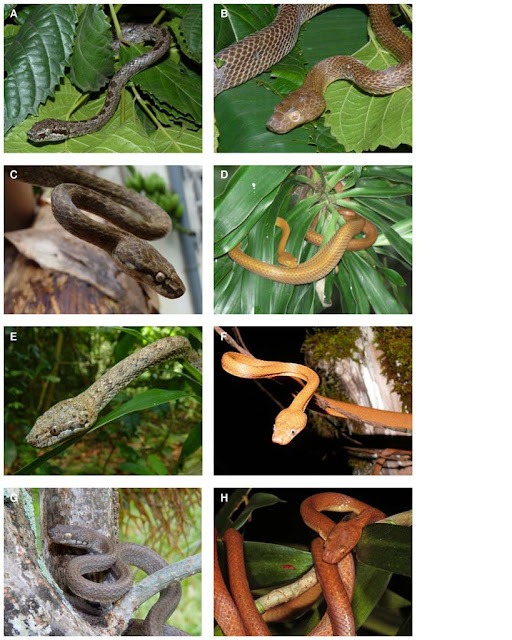The Tree Snakes of the Comoros Islands have traditionally been clasified as being members of a single species, Lycodryas sanctijohannis, or the Saint John's Treesnake, despite considerable differences between the Snakes on different Islands.
In a paper published in the journal PLoS One on 24 August 2012, Oliver Hawlitschek of the Zoologische Staatssammlung Munchen, Zoltan Nagy of the Joint Experimental Molecular Unit at the Royal Belgian Institute of Natural Sciences, and Frank Glaw, also of the Zoologische Staatssammlung Munchen, redescribe the Treesnakes of the Comoros, coming to the conclusion that there are in fact two species of snakes in the islands, each of which should be subdivided into two subspecies, and none of which should be described as Lycodryas sanctijohannis.
The generic name Lycodryas is used for Treesnakes from the islands of the southwest Indian Ocean. The species sanctijohannis was descibed in 1879, based upon a specimen from Mayote Island, however Hawlitschek et al. discovered that a specimen in the British Museum of Natural History described in 1858 as Dipsadoboa maculata, and misidentified as coming from Central America, was in fact a Treesnake from Anjouan, and belonged to the same species as the specimen described as Lycodryas sanctijohannis. Under the complex and somewhat legalistic rules of Taxonomy, the earliest name given to a species is presumed to have precedence, even if the description is very poor. The Mayote Treesnake clearly does not belong in the genus Disadoboa, a group of New World Treesnakes only distantly related to the Snakes of the Comoros, but the specific name maculata is still the earliest name given to a Mayote Treesnake, so the correct name from these snakes should be Lycodryus maculata.
Hawlitschek et al. concluded that the Treesnakes of Mayote and Anjouan belonged to the same species, but were sufficiently different both genetically and morphologically to justify their placement in different subspecies. The Snakes of Anjouan are therefore described as Lycodryas maculata maculata, and the Snakes of Mayote as Lycodryas maculata comorensis. The Snakes of Grand Comoro and Moheli were judged to be sufficiently diffrent to be placed in a different species, named Lycodryus cococola, from Cocos (Coconut) and Cola (Inhabiting), making this the Coconut Treesnake (although the pun probably was intended). Snakes from Grand Comoro are described as Lycodryus cococola cococola and those from Moheli as Lycodrus cococola innocens, meaning inocent; the inhabitants of Moheli being particularly affraid of the snake, and prones to persecuting it, despite the snake being harmless and inoffensive.
Map showing this distribution of Treesnakes in the Comoros. Hawlitschek et al. (2012).
Treesnakes of the Comoros. (A) Male Lycodrus maculata maculata from Anjouan. (B) Female Lycodrus maculata maculata from Anjouan. (C) Male Lycodryus maculata comorens from Mayote. (D) Female Lycodryus maculata comorens from Mayote. (E) Male Lycodrus cococola innocens from Mohile. (F) Female Lycodrus cococola innocens from Mohile. (G) Male Lycodrus cococola cococola from Grand Comoro. (H) Female Lycodrus cococola cococola from Grand Comoro. Hawlitschek et al. (2012).
See also New species of Asian Coral Snake from western India, Velvet Geckos and Broad-headed Snakes; understanding the population structure of a favored prey item in order to help protect an endangered predator, Eruption on Mount Karthala and Reptiles on Sciency Thoughts YouTube.
Follow Sciency Thoughts on Facebook.
Follow Sciency Thoughts on Facebook.


